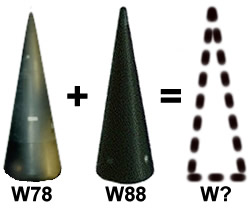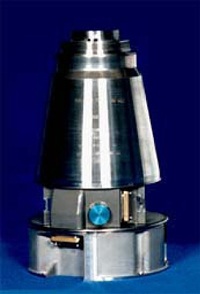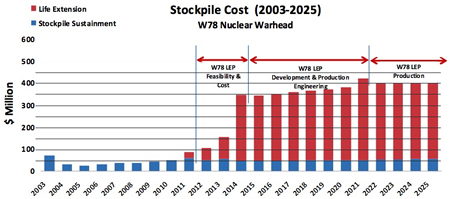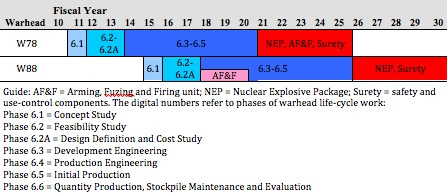 |
| A white paper describes plans for a joint warhead. |
By Hans M. Kristensen
The National Nuclear Security Administration (NNSA) has sent Congress a white paper describing plans for extending the life of the W78 warhead on the Minuteman III intercontinental ballistic missile (ICBM).
According to the paper, W78 Life Extension Program Description and Work Scope, a Phase 6.1 study would begin in February 2011 and seek to produce the first warhead in 2021.
Although focused on extending the life of the W78 warhead itself, the study includes an adaptable warhead option to join the W78 and W88 warheads for the purpose of producing a modified warhead that can be deployed on both the Minuteman and the Navy’s Trident II D5 sea-launched ballistic missile (SLBM).
A Joint Warhead
The NNSA white paper states that the Phase 6.1 study will explore the “W78 Military Characteristics (MCs) including military requirements for a system that could be fielded with both the Mk12A and Mk5 reentry systems.”
A joint warhead option raises important questions: How different will the new warhead be compared with the current W78 and W88 types? Will it be closer to the W78 or the W88 design? Will it be a “reliable replacement warhead”?
Part of the white paper language suggests that the joint warhead might be closer to the W78 than the W88. Indeed, the initial requirement for the W78 back in the 1970s was for both ICBM and SLBM deployment:
“The planned approach represents an important opportunity to extend W78 service life, incorporate modern safety, security, and control features and, if the W78 LEP is also able to address the requirements of the W88, gain substantial efficiencies and cost reduction. In fact, the original MCs of the W78 (published in 1974) defined a requirement, yet technologically unmet, for a nuclear warhead for both the Minuteman III and the Trident II delivery systems. This was not feasible then but, in all likelihood, is feasible today.” (Emphasis added)
The white paper promises that, “the W78 LEP will use only nuclear components based on previously tested designs, and will not support new military missions or provide for new military capabilities.”
But for a joint warhead option, a W78 LEP deployed on SLBMs will obviously have to meet similar military requirements as the W88. Both warheads are hard-target kill weapons, yet the yield of the W88 is more than 100 kt greater than the W78 (see table). So unless the military reduces its requirements for the SLBM mission, then the capability of the W78 LEP warhead obviously would have to be increased to meet both missions.
| W78 and W88 Warhead Profiles |
 |
| * Pits (plutonium cores) for W88 replacement warheads are currently being produced at the Los Alamos National Laboratory. |
.
The W78 and W88 designs currently have “single yield” so one possibility could be to add more yield options to a joint warhead to meet both missions. A new Arming, Fuzing and firing (AF&F) unit might also provide new targeting flexibility that improves the kill capability of the warhead (similarly to the Mk4A/W76-1 SLBM warhead currently being produced). Or a decision to increase the accuracy of the missiles could reduce the yield requirement.
Regardless of which design option is chosen, a joint warhead would appear to require some new military capabilities.
NNSA’s previous warhead refurbishment chart from FY2009 did not list a new AF&F for the W78 LEP, nor did it list new surety features for the W78 or W88 warhead. But the chart in the FY2011 Stockpile Stewardship Management Plan (SSMP) lists new AF&F and surety features for all future life-extension programs (see chart).
| Scheduled W78 and W88 Life Extension Programs |
|
|
| Following immediately after scheduled completion of the W76 and W61 life extension programs, the administration is planning life extension programs for the W78 and W88 warheads. A joint ICBM-SLBM warhead would combine the W78 and W88 programs. |
.
How Many Warheads?
If the joint warhead becomes a modified version of the W78, what will happen to the W88? The Nuclear Posture Review stated that the W78 LEP study would examine “the possibility of using the resulting warhead also on SLBMs to reduce the number of warhead types.” (Emphasis added) And a joint warhead, the NNSA white paper states, “could provide opportunities to reduce further reserve warheads.” (Emphasis added)
That language suggests an intention to replace the W88. If so, how many W78 LEP warheads would be needed for both missions?
Nearly 1,000 W78 warheads were produced between 1979 and 1982, but only 250 or so are currently deployed with an additional 350 in reserve for a total of about 600 W78s remaining in the stockpile. Over the years, a couple of hundred W78s have been consumed in destructive quality control experiments.
Approximately 400 W88s were produced between 1989 and 1991, of which roughly 380 are deployed. Warheads lost in destructive quality control experiments are currently being replaced by new production warheads at Los Alamos National Laboratory.
Assuming the number of deployed ICBMs and SLBMs will shrink to 420 and 240, respectively, over the next decade, the potential number of new joint warheads might be roughly 800 (in addition to the W87 and W76-1s deployed on the two platforms).
Stockpile Diversity and Reliability
A strategy to reduce warhead types is different from the RRW program of the Bush administration, which argued that replacement of warheads was important partly to preserve “diversity” of the stockpile. The thinking was that two warhead types per delivery platform would safeguard against a catastrophic technical warhead defect crippling a leg of the Triad.
Since a joint ICBM/SLBM warhead would reduce the warhead types for those platforms from four to three, a technical failure of the joint warhead would significantly affect the capability of both legs, instead of just one of them. That, ironically, could increase the vulnerability of the two legs and drive a requirement to maintain more W87 and W76-1 warheads in reserve than otherwise.
 |
| The administration is rushing a W88 AF&F replacement in 2018-2919, well ahead of the full LEP schedule. |
The white paper states that “the W78 LEP will use only nuclear components based on previously tested designs,” a pledge also made by the NPR. But the addition of new components such as the AF&F and safety and security features can potentially create serious risks for predicting weapons reliability.
Some of the safety features being explored by the weapons labs include replacing chemical high explosives (CHE) with insensitive high explosives (IHE), and adding multi-point safety to the warheads.
Except for the W87, all U.S. ballistic missile warheads have conventional high explosives, potentially making them less safe than the W87. The newest missile warhead, the W88, was designed with the less safe explosive to reduce weight in order to increase the number of warheads that would be delivered by each missile. Using the W87 to replace the W88 would seem a better option (although the W87 yield is less than the W78), but there are too few W87s in the stockpile to load both ICBMs and SLBMs and the warhead is not scheduled for an LEP until the late-2030s. Another way to increase safety is to handle the warheads less and improve handling procedures. Deploying warheads on high alert, for example, significantly increases safety risks.
All warheads are currently single-point safe, which means if the high explosive is detonated at any single point, there will be less than one chance in a million that more yield will result than the equivalent to exploding four pounds of high explosives. Multi-point safety would ensure the same safety margin if multiple high explosives detonated simultaneously, but that would require significant changes to the warhead design and potentially decrease confidence in its reliability. Besides, no warhead accident has ever resulted in a nuclear yield.
In other words, the risks and uncertainties associated with producing a new joint warhead are many and it is far from clear that they would allow a reduction of the number of reserve warheads.
Cost Projections
The NNSA white paper does not include cost projections for the W78 LEP, but the FY2011 Stockpile Stewardship Management Plan does. Through 2025, the program is projected to cost more than $4 billion, or roughly $7 million per stockpiled W78 warhead.
| Projected W78 Life Extension Program Costs |
 |
| The administration projects the cost of the W78 life extension program will reach more than $4 billion through 2025. A joint ICBM-SLBM warhead would increase costs significantly. |
.
Combining the W78 and W88 would significantly increase this cost projection.
The administration’s budget includes $26 million to begin the Phase 6.1 study in February 2011, and STRATCOM apparently has already completed its assessment for a joint warhead but has not yet released its report.
But the Phase 6.1 study cannot begin until the Pentagon provides Congress with a clear need or military requirement for NNSA to pursue the joint warhead option. There are many questions that need to be answered.
This publication was made possible by a grant from Carnegie Corporation of New York and Ploughshares Fund. The statements made and views expressed are solely the responsibility of the author.
The FY2026 National Defense Authorization Act (NDAA) paints a picture of a Congress that is working to both protect and accelerate nuclear modernization programs while simultaneously lacking trust in the Pentagon and the Department of Energy to execute them.
While advanced Chinese language proficiency and cultural familiarity remain irreplaceable skills, they are neither necessary nor sufficient for successful open-source analysis on China’s nuclear forces.
Satellite imagery has long served as a tool for observing on-the-ground activity worldwide, and offers especially valuable insights into the operation, development, and physical features related to nuclear technology.
This report outlines a framework relying on “Cooperative Technical Means” for effective arms control verification based on remote sensing, avoiding on-site inspections but maintaining a level of transparency that allows for immediate detection of changes in nuclear posture or a significant build-up above agreed limits.
